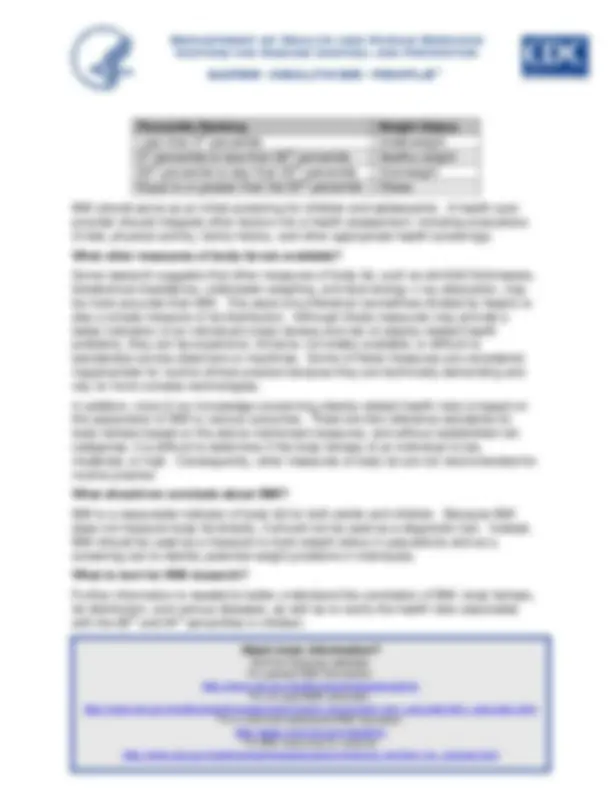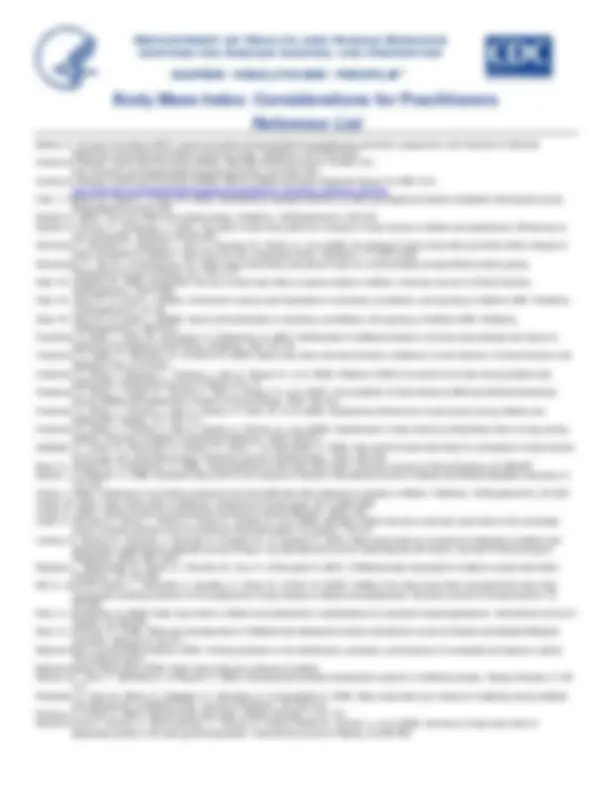




Study with the several resources on Docsity

Earn points by helping other students or get them with a premium plan


Prepare for your exams
Study with the several resources on Docsity

Earn points to download
Earn points by helping other students or get them with a premium plan
Community
Ask the community for help and clear up your study doubts
Discover the best universities in your country according to Docsity users
Free resources
Download our free guides on studying techniques, anxiety management strategies, and thesis advice from Docsity tutors
Although BMI is often considered an indicator of body fatness, it is a surrogate measure of body fat because it measures excess weight rather than excess fat.
Typology: Lecture notes
1 / 4

This page cannot be seen from the preview
Don't miss anything!



th
th
th
Barlow, S., & Expert Committee (2007). Expert committee recommendations regarding the prevention, assessment, and treatment of child and adolescent overweight and obesity: Summary report. Pediatrics, 120 , S164-S192. Centers for Disease Control and Prevention (2009a). Adult BMI Retrieved August 10 2009, from http://www.cdc.gov/healthyweight/assessing/bmi/adult_bmi/index.html Centers for Disease Control and Prevention (2009b). BMI for children and teens Retrieved August 10, 2009, from http://www.cdc.gov/healthyweight/assessing/bmi/childrens_bmi/about_childrens_bmi.html Cole, T., Bellizzi, M., Flegal, K., & Dietz, W. (2000). Establishing a standard definition for child overweight and obesity worldwide: international survey. British Medical Journal, 320. Daniels, S. (2009). The use of BMI in the clinical setting. Pediatrics, 124 (Supplement1), S35-S41. Daniels, S., Khoury, P., & Morrison, J. (1997). The utility of body mass index as a measure of body fatness in children and adolescents: Differences by race and gender. Pediatrics, 99 , 804-807. Demerath, E., Schubert, C., Maynard, L., Sun, S., Chumlea, W., Pickoff, A., et al. (2006). Do changes in body mass index percentile reflect changes in body composition in children? Data from the Fels Longitudinal Study. Pediatrics, 117 , e487-e495. Deurenberg, P., Yap, M., & VanStaveren, W. (1998). Body mass index and percent body fat: a meta analysis among different ethnic groups. International Journal of Obesity, 22 , 1164-1171. Dietz, W., & Bellizzi, M. (1999). Introduction: the use of body mass index to assess obesity in children. American Journal of Clinical Nutrition, 70 (Supplement), 123S-125S. Dietz, W., Story, M., & Leviton, L. (2009a). Introduction to issues and implications of screening, surveillance, and reporting of children's BMI. Pediatrics, 124 (Supplement1), S1-S2. Dietz, W., Story, M., & Leviton, L. (2009b). Issues and implications of screening, surveillance, and reporting of children's BMI. Pediatrics, 124 (Supplement1), S98-S101. Freedman, D., Kahn, L., Dietz, W., Srinivasan, S., & Berenson, G. (2001). Relationship of childhood obesity to coronary heart disease risk factors in adulthood: the Bogalusa Heart Study. Pediatrics, 108 , 712-718. Freedman, D., Ogden, C., Berenson, G., & Horlick, M. (2005). Body mass index and body fatness in childhood. Current Opinion in Clinical Nutrition and Metabolic Care, 8 , 618-623. Freedman, D., Wang, J., Maynard, L., Thornton, J., Mei, Z., Pierson, R., et al. (2005). Relation of BMI to fat and fat-free mass among children and adolescents. International Journal of Obesity, 29 , 1-8. Freedman, D., Wang, J., Ogden, C., Thornton, J., Mei, Z., Pierson, R., et al. (2007). The prediction of body fatness by BMI and skinfold thicknesses among children and adolescents. Annals of Human Biology, 34 (2), 183-194. Freedman, D., Wang, J., Thornton, J., Mei, Z., Pierson, R., Dietz, W., et al. (2008). Racial/ethnic differences in body fatness among children and adolescents. Obesity, 16 , 1105-1111. Freedman, D., Wang, J., Thornton, J., Mei, Z., Sopher, A., Pierson, R., et al. (2009). Classification of body fatness by Body Mass Index-for-Age among children. Archives of Pediatric & Adolescent Medicine, 163 (9), 805-811. Gallagher, D., Visser, M., Sepulveda, D., Pierson, R., Harris, T., & Heymsfield, S. (1996). How useful is body mass index for comparison of body fatness across age, sex, and ethnic groups? American Journal of Epidemiology, 143 (3), 228-239. Garn, S., Leonard, W., & Hawthorne, V. (1986). Three limitations of the body mass index. American Journal of Clinical Nutrition, 44 , 996-997. Garrow, J., & Webster, J. (1985). Quetelet's index (W/H 2 ) as a measure of fatness. International Journal of Obesity and Related Metabolic Disorders, 9 , 147-153. Himes, J. (2009). Challenges of accurately measuring and using BMI and other indicators of obesity in children. Pediatrics, 124 (Supplement1), S3-S22. Horlick, M. (2001). Body mass index in childhood--measuring a moving target. 86, 9 , 4059-4060. Lesser, G. (2007). Issues in body fat measurement Archives of Internal Medicine, 169 (6), 636. Lewis, C., McTigue, K., Burke, L., Poirier, P., Eckel, R., Howard, B., et al. (2009). Mortality, health outcomes, and body mass index in the overweight range: a science advisory from the American Heart Association. Circulation, 119 , 0-0. Lindsay, R., Hanson, R., Roumain, J., Ravussin, E., Knowler, W., & Tataranni, P. (2001). Body mass index as a measure of adiposity in children and adolescents: relationship to adiposity by dual energy x-ray absorptiometry and to cardiovascular risk factors. Journal of Endocrinology & Metabolism, 86 (9), 4061-4067. Maynard, L., Wisemandle, W., Roche, A., Chumlea, W., Guo, S., & Siervogel, R. (2001). Childhood body composition in relation to body mass index. Pediatrics, 107 , 344-350. Mei, Z., Grummer-Strawn, L., Pietrobelli, A., Goulding, A., Goran, M., & Dietz, W. (2002). Validity of the body mass index compared with other body- composition screening indexes for the assessment of body fatness in children and adolescents. American Journal of Clinical Nutrition, 75 , 978-985. Must, A., & Anderson, S. (2006). Body mass index in children and adolescents: considerations for population-based applications. International Journal of Obesity, 30 , 590-594. Must, A., & Strauss, R. (1999). Risks and consequences of childhood and adolescent obesity International Journal of Obesity and Related Metabolic Disorders, 23 (Suppl 2), S2-S11. National Heart Lung and Blood Institute (1998). Clinical guidelines on the identification, evaluation, and treatment of overweight and obesity in adults: The evidence report. National Obesity Observatory (2009). Body mass index as a measure of obesity. Neovius, N., Linne, Y., Barkeling, B., & Rossner, S. (2004). Discrepancies between classification systems of childhood obesity. Obesity Reviews, 5 , 105-
Pietrobelli, A., Faith, M., Allison, D., Gallagher, D., Chiumello, G., & Heymsfield, S. (1998). Body mass index as a measure of adiposity among children and adolescents: a validation study. Journal of Pediatrics, 132 , 204-210. Prentice, A., & Jebb, S. (2001). Beyond body mass index. Obesity Reviews, 2 , 141-147. Romero-Corral, A., Somers, V., Sierra-Johnson, J., Thomas, R., Collazo-Clavell, M., Korinek, J., et al. (2008). Accuracy of body mass index in diagnosing obesity in the adult general population. International Journal of Obesity, 32 , 959-966.